Homestead Garden Plan – Year Round Food on 1/4 Acre
Year-round self-sufficiency is possible—even in small spaces! This homestead garden plan offers ideas to not just grow vegetables, but also protein, fruit, storage crops, and more to stockpile your own food.
Having a summer garden is lovely. Who doesn’t love fresh produce in the spring through fall? But will a few tomato plants and some leafy greens be enough to give you the food security you are looking for on your homestead?
What about those long winter months? How do you plan your garden to feed your family well beyond the gardening season?
On just a 1/4 acre of our property, we can grow well over half of the food our family consumes each year. This includes meat, fruit, and a variety of energy-rich storage crops that we harvested last year and are still eating into July.
How Our Self-Sufficient Homestead Garden Began
After moving onto our 5-acre homestead, relying on the grocery store for our food just didn’t seem to make sense anymore. We desired a more self-sufficient, homegrown life.
Learning the secret to feeding ourselves through the winter would be key. So, we looked at how our ancestors grew, preserved, stored, and prepared food before the era of stocked supermarket shelves.
This looked like baskets full of potatoes in the cellar. Chickens on hand to butcher for a quick source of protein any given day or week. Thick-skinned squash laid out in single layers that lasted until the following year’s harvest. And storage varieties of apples and other fruits that stay fresh long into the winter and early spring months.
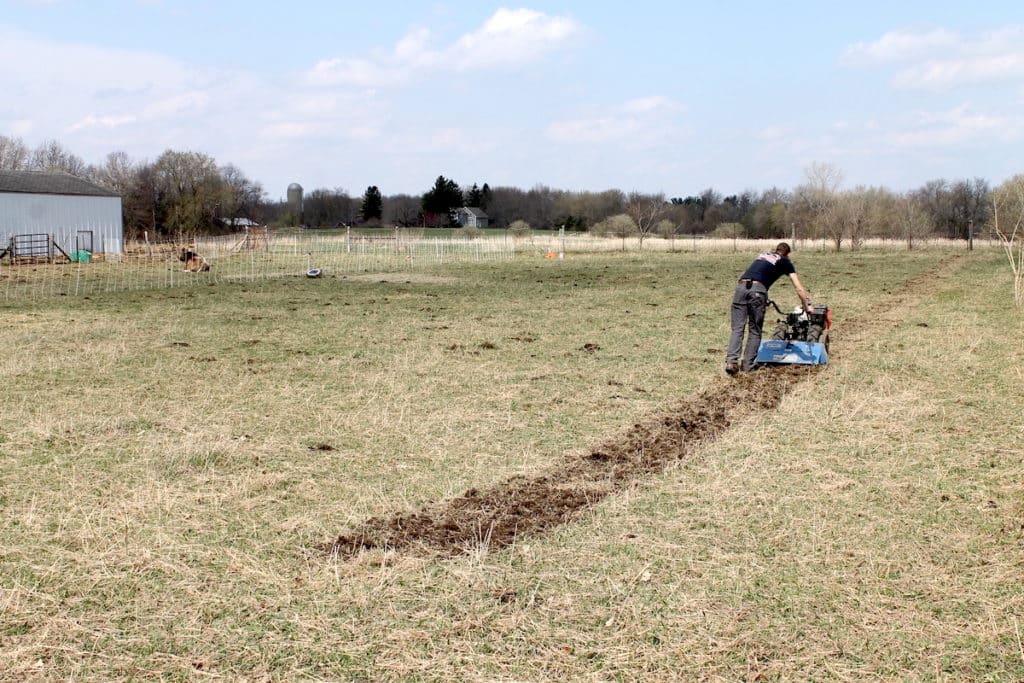
Was all this possible on our land? And how big of a space did we need for all of it?
In the winter of 2020-21, the design challenge was on. Below is a breakdown of the homestead garden plan we came up with and how it’s worked so far.
But first, a little on the philosophy and goals behind our garden planning and homestead layout.
Developing Whole Farm Systems
No one part of any farm stands alone. Instead, we see our job as creating a whole farm ecosystem. Each piece should work in harmony and be a companion with the whole.
For instance, an orchard provides diverse habitat for beneficial insects. Raising animals allows for natural forms of land management and creates good quality compost to replenish your soils. Growing a diverse range of crops increases your land’s resilience to drought, pests, or disease. Practices like cover crops and crop rotation give your garden longevity and good soil quality. They all make up the whole.
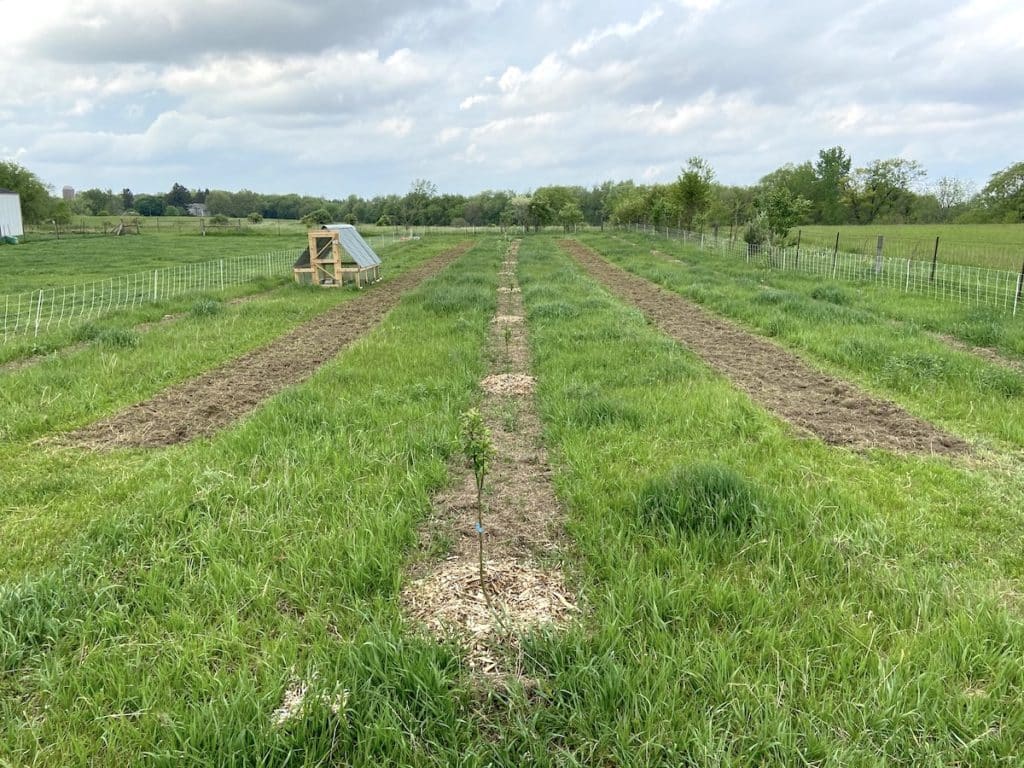
The things we were planning to grow were:
- Fruit trees
- Chickens for meat
- Three sisters garden (corn, beans, squash)
- Potatoes
- Other storage crops (carrots, beets, turnips, garlic, etc.)
- Honeybees
The question rolling around in our brain is how can we establish all these things on our homestead in one single space and system that works together. Some ideas started to form and it became clear that fruit trees were step one.
Not everything on the list above may resonate with you. That’s totally fine! These are the foods we’ve found to be most helpful to grow on our land to be less dependent on the global food system. Take or leave what you want from our homestead garden plan, but our goal is to offer ideas, inspire, and show what’s possible in a small space—even beyond typical vegetable gardening.
Step 1: Starting with Fruit Trees
The only permanent things from the list above were fruit trees. That would be our starting point! We targeted a long, rectangular part of our property that was flat with full sun. It turned out to be about a 1/4 acre space.
We ordered 30 fruit trees to come that spring and tilled up 3 long rows where the fruit trees would be planted. Each row was approximately 175’ long, 3-4’ wide, and about 18’ feet apart. This gave about 16-18’ of spacing between each fruit tree in any direction.
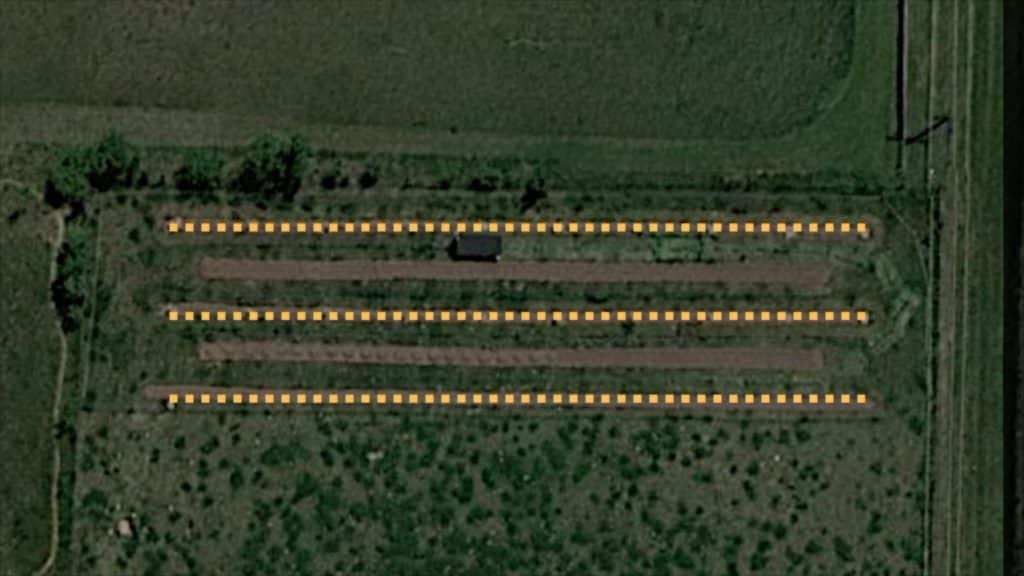
While we knew it would be years before these trees produced fruit, it was a worthwhile investment to make early in our homesteading journey. In our post, Beginners Guide to Homestead Fruit Trees, we talk all about planning out an orchard and how to source your trees. We ordered from Fedco and planted unique, heirloom varieties—many of which are optimized for storage through the winter.
So, our orchard was established! But what about the rest?
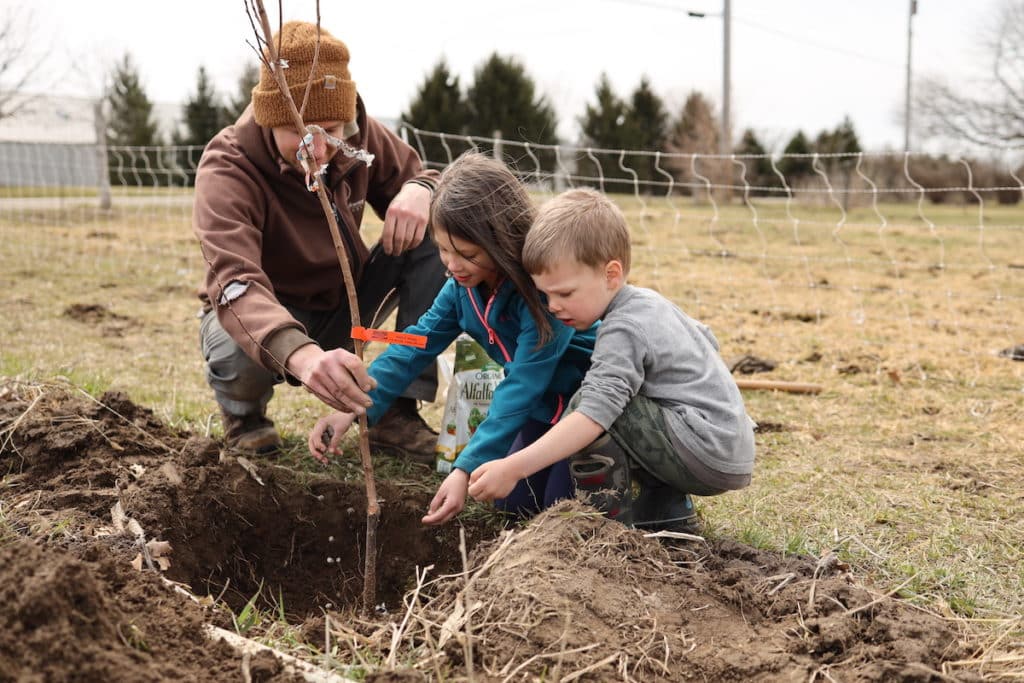
Step 2: Planting a Three Sisters Garden
We had recently been introduced to the three sisters gardening method. This brilliantly simple companion planting method produces incredible amounts of food—corn, beans, and squash—that sustained generations of Native Americans.
So, between the three rows of fruit trees, we tilled up two more long rows—each about 150’ long. Following the traditional planting technique, we created mounds about every 4’. These mounds act as garden beds where we planted the corn and beans. Then, between each mound our squash plants were planted.
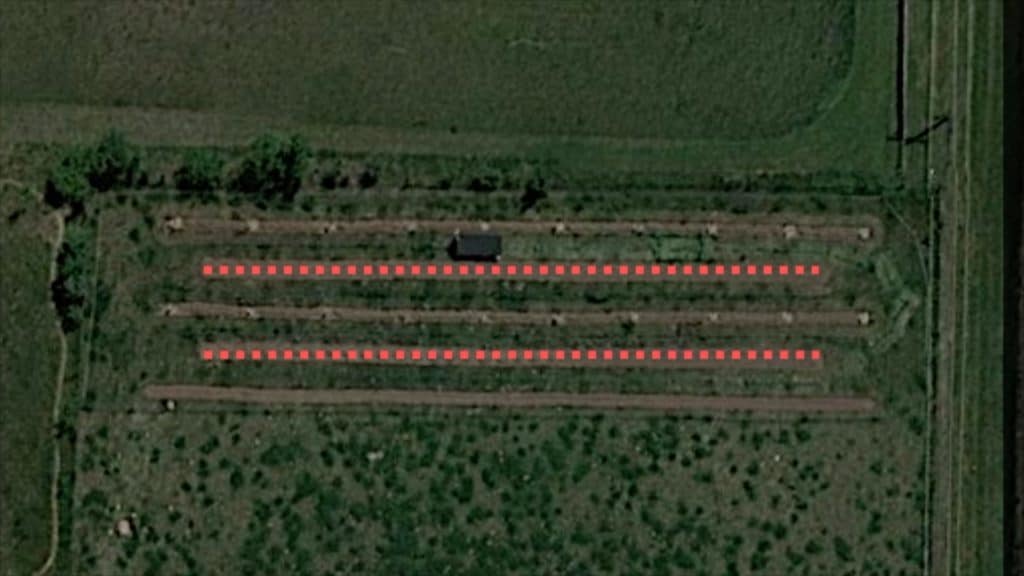
We probably shouldn’t have been as amazed as we were given the age-old wisdom this system carried with it. But it all flourished and did exactly what it was supposed to! The corn grew tall, the beans trellised up the stalks, and the squash created a massive ground cover over all of it.
Pound for pound of food grown, and square foot for square foot of space, a three sisters garden can be remarkably productive toward growing a year’s worth of food.
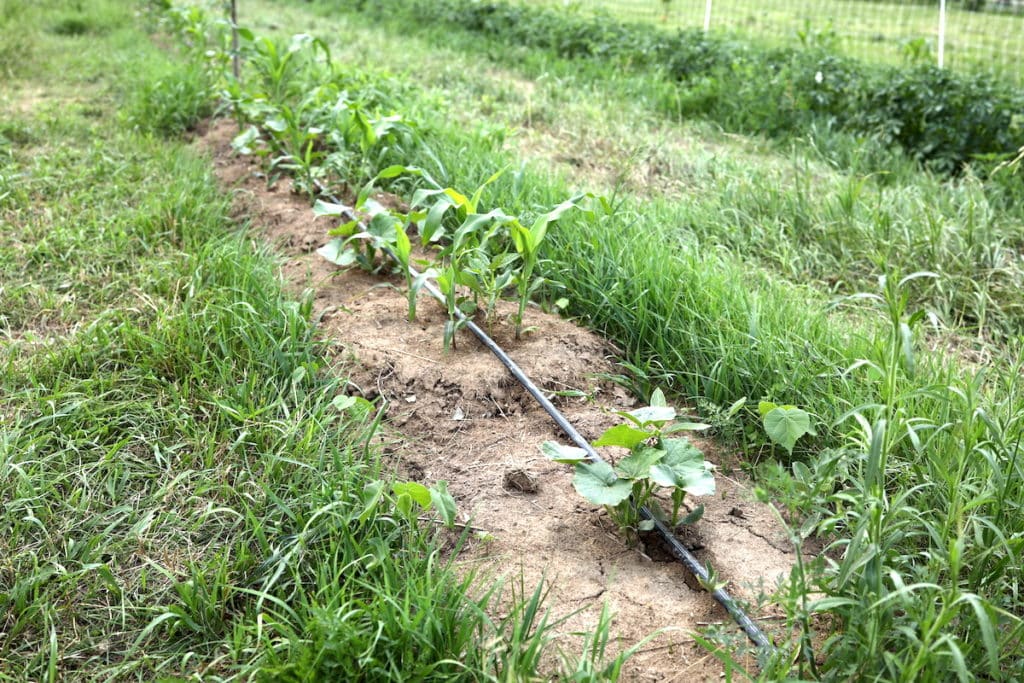
Step 3: Planting Potatoes and Other Storage Crops
Remember how we tilled up those long rows for the trees? Well, that left a lot of cultivated, fertile stretches of soil between those trees. In them we initially planted potatoes. Lots of potatoes. Over 50 lbs. worth.
And the payout was massive! Each year we’ve grown potatoes we’ve harvested several hundred pounds worth in the fall. We’ve learned a lot about long-term storage of potatoes and also how to still utilize them once they’ve gone soft.
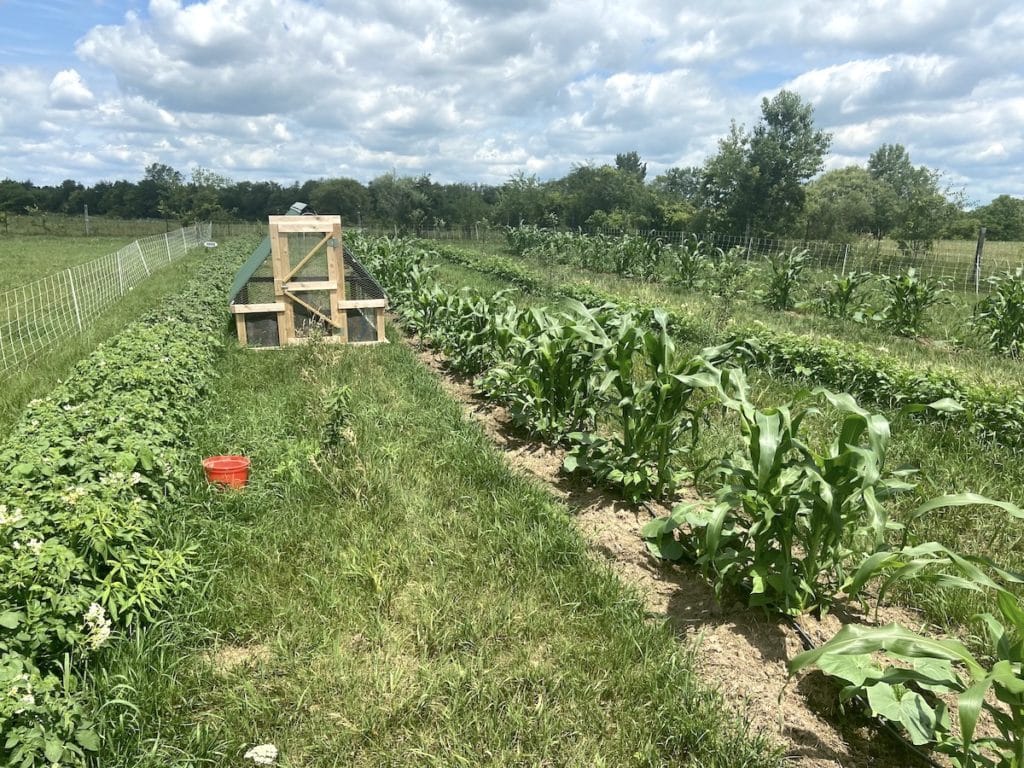
These tree rows can also be great for planting other storage crop varieties. We’ve had lots of success utilizing them to plant garlic in the fall and then harvesting fresh scapes and garlic the following year. We’ve also used them to plant other root storage crops like carrots, beets, and turnips.
A great way to maximize the growing space in these rows would be to utilize succession planting. For instance, when garlic is harvested in the late spring or early summer, carrot seed can be planted that same growing season for a fall carrot harvest. Then in the late fall, you can plant garlic again and start the process all over again!
Step 4: Raising Chickens for Meat
The spacing between our rows was determined by the dimensions of the Suscovich Chicken Tractor we built to raise our meat chickens in. The tractor measures 6’ wide. So, between each tilled row, we left a 6’ grassed alleyway.
We pull the chicken tractor through those rows, moving them twice a day. This allows us to raise our meat chickens on fresh pasture. Our chickens thrived in this system where they act out their natural foraging instincts and help offset the cost of feed.
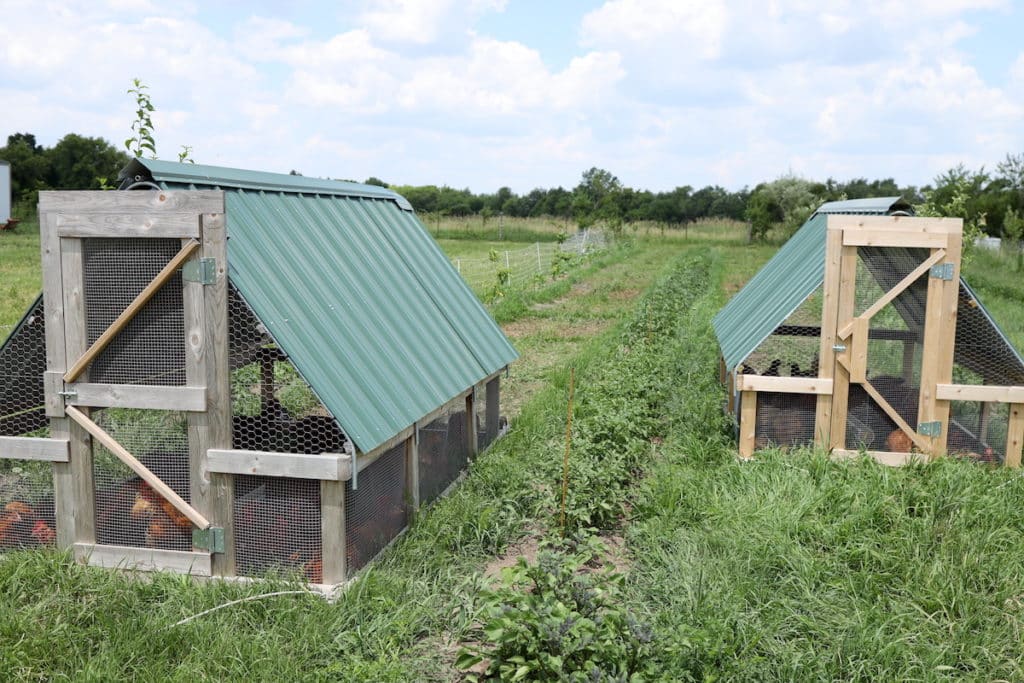
Moving the chicken tractor through the pastured alleyways also helps cycle nutrients and organic matter back into the soil of our homestead garden. The chickens are never in one spot for long. So, their manure is evenly distributed and not concentrated in any one area. Plus, the chickens can help rid the garden of any pests that try to invade.
Step 5: Adding Bee Hives
We also recently added 5 beehives to the corner of this rectangular large garden system. Between the trees, pasture, and crops, there is continuous flowering happening throughout the season. Since the crops growing within this system rely heavily on pollinators, we look forward to having the honeybees close by. And harvesting fresh, raw honey along with beeswax is an additional benefit!
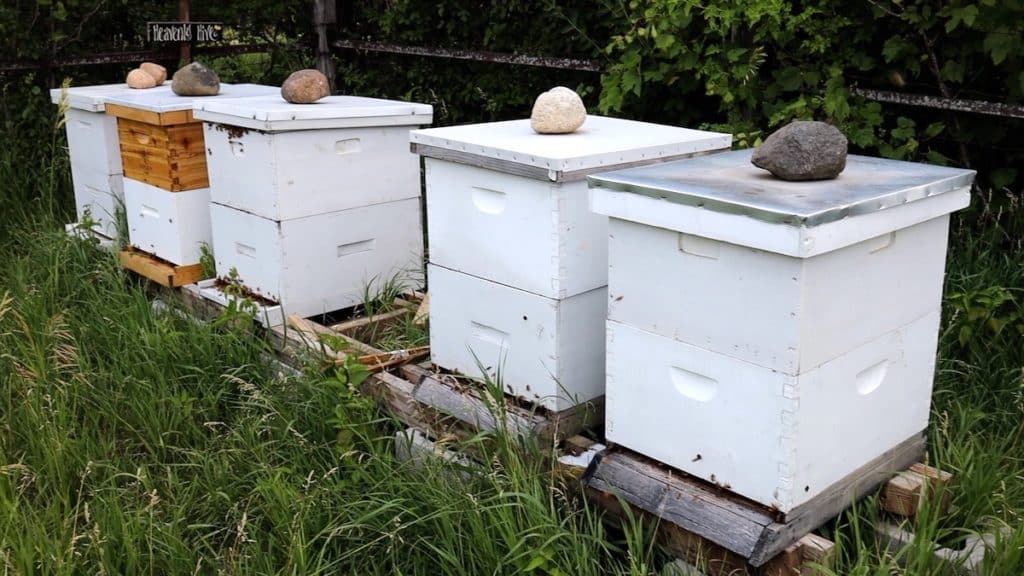
What We Are Learning and How We Are Adapting
With a couple of growing seasons under our belt, we are continuing to make changes and refine this system for the future. Here’s some takeaways:
1. Rotating Crops
We knew it wouldn’t be wise to plant the same crops in the same locations. Especially with growing crops like potatoes and squash that are susceptible to pests when not rotated. So, we’ve been making sure to rotate the rows where we plant a three sisters garden with the rows we plant potatoes each year. So far this seems to be working great!
2. Building a Second Chicken Tractor
Our first year went smoothly but one challenge kept popping up—fighting back the sprawling squash plants! We raised two rounds of meat chickens spanning into early August. Keeping the grassed alleyways clear of squash plants this long to pull the chicken tractor through was no simple task. To remedy this, we built a second tractor and raised a double batch of meat chickens early in the season. A less irritated gardener + happy squash plants = winning all around!
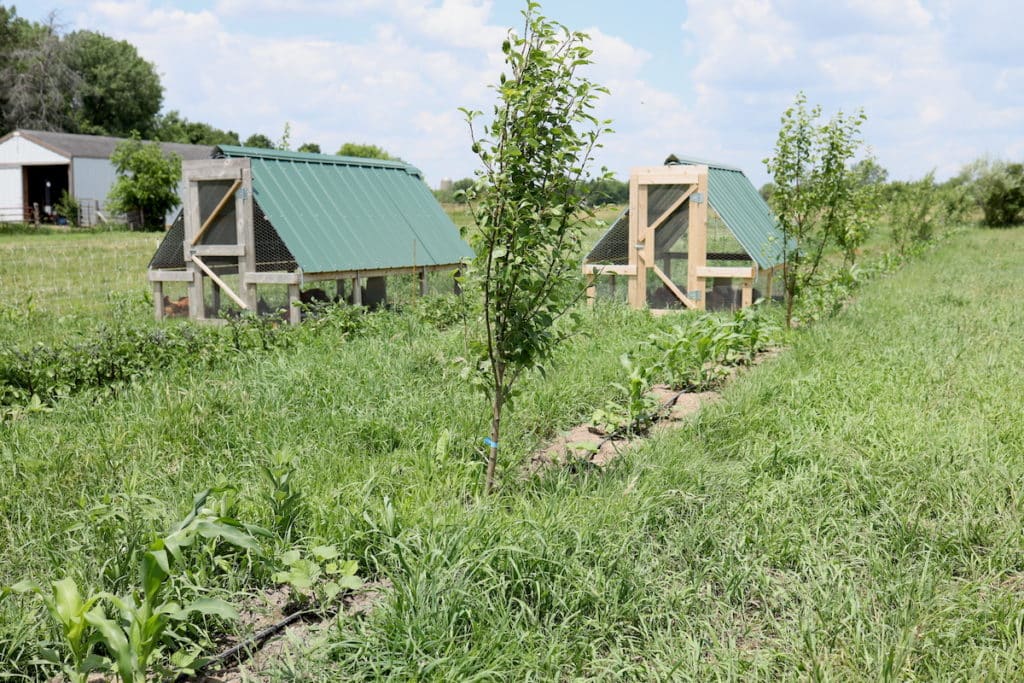
3. Rethinking What We Plant in the Tree Rows
We realize eventually we will need to stop planting in the rows with the trees. We’ll need to abandon planting annual crops in those rows after a couple years. The tree roots are establishing more and eventually, they will get big enough to shade out whatever is growing under them. We may establish one or two more rows for planting on the outside of the current rows. Or, we may simply just plant in the two existing 150’ rows. So far, this garden space has produced more than our family needs. So, planting in less space may very well simplify things and produce an appropriate amount for our family.
On that note, we are also considering planting something more permanent in those tree rows like berry bushes, raspberries, or strawberries. These will add to the perennial and bountiful harvest this garden area can provide down the road!
The Self-Sufficient Homestead Garden Harvest
That first fall, we were blown away with how much food we produced without much space. We had close to 1,000 lbs. of potatoes, hundreds of winter squash, buckets of beans and corn, and 40+ chickens in the freezer. This year, we already have 63 chickens in the freezer and the gardens are looking strong!
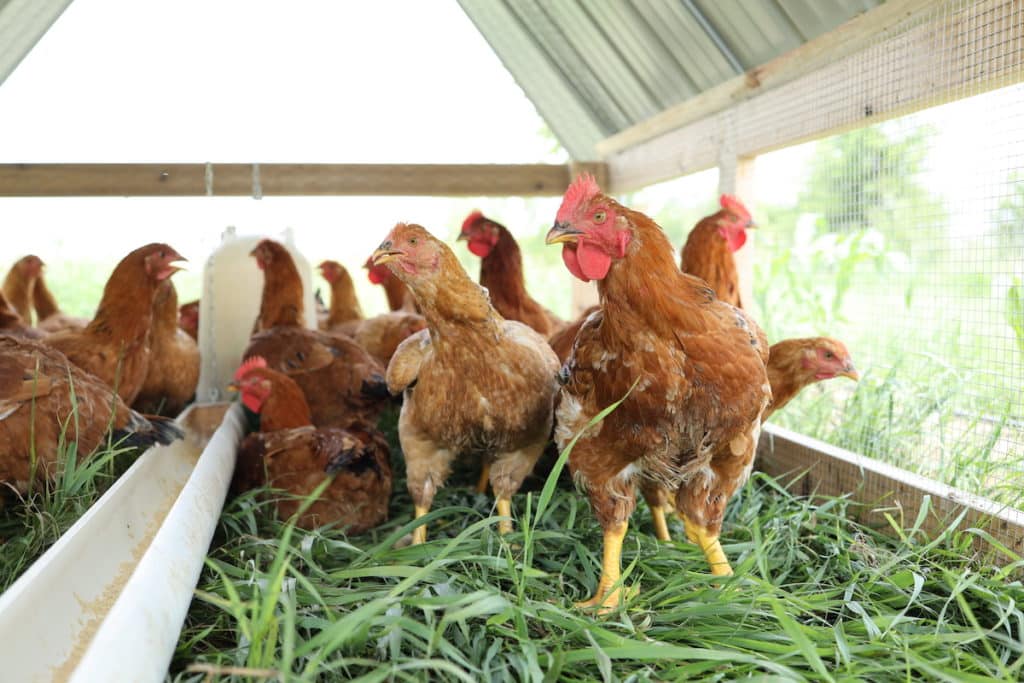
We are still in the early stages of our homesteading journey. What we want you to know is that it’s totally possible to raise meat, fruit, and storage crops to feed your family all year round.
And it doesn’t have to look at all like what we’ve laid out. Yes, it’s possible to reproduce this exact system on some properties. But what if your property doesn’t have a full 1/4 acre for planting? Or you’re in a suburban or urban setting?
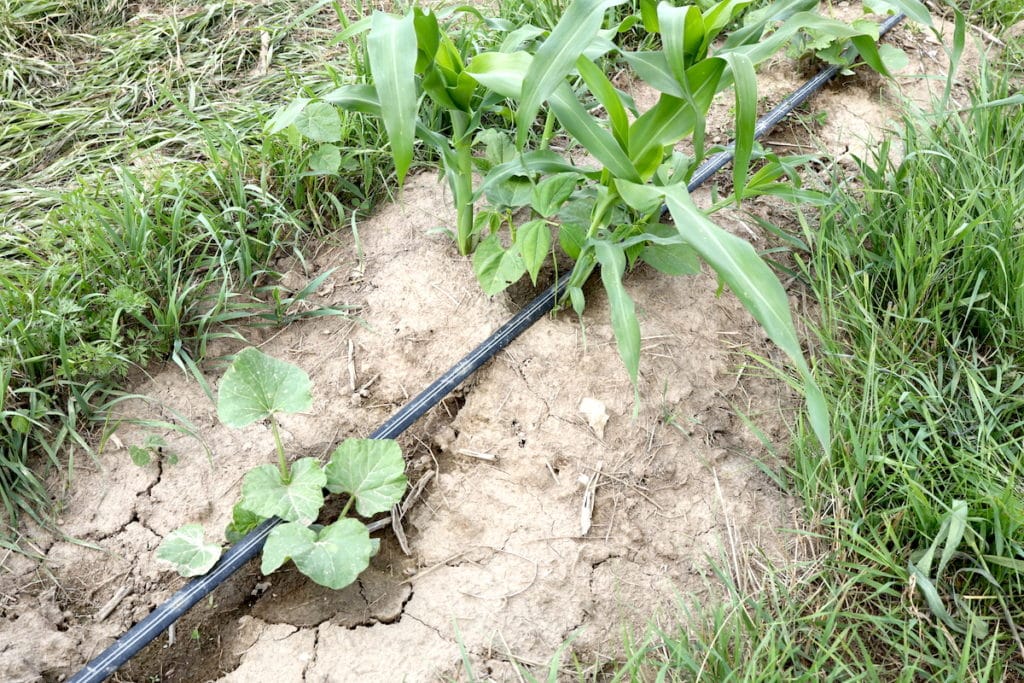
You can still grow SO much food! A three sisters garden can be planted in any unused space on your property. You can build raised beds and plant different varieties of storage crops. You can have container gardens with potatoes and much more on your patio. Chicken tractors can be built to fit in almost any yard space. And hey, don’t limit yourself to a backyard garden. As we found out when we lived in the suburbs, the front yard is a great option too!
Where are you at and what steps are you taking toward self-sufficiency? We’d love to hear from you!
Interested in more self sufficient living topics? Check out these posts:
- Beginners Guide To Self Sufficient Homesteading
- Cornish Cross Vs. Freedom Ranger Chickens
- Chicken Tractor Plans For 25 Chickens
- Beginners Guide To Homestead Fruit Trees
Pin it for later!
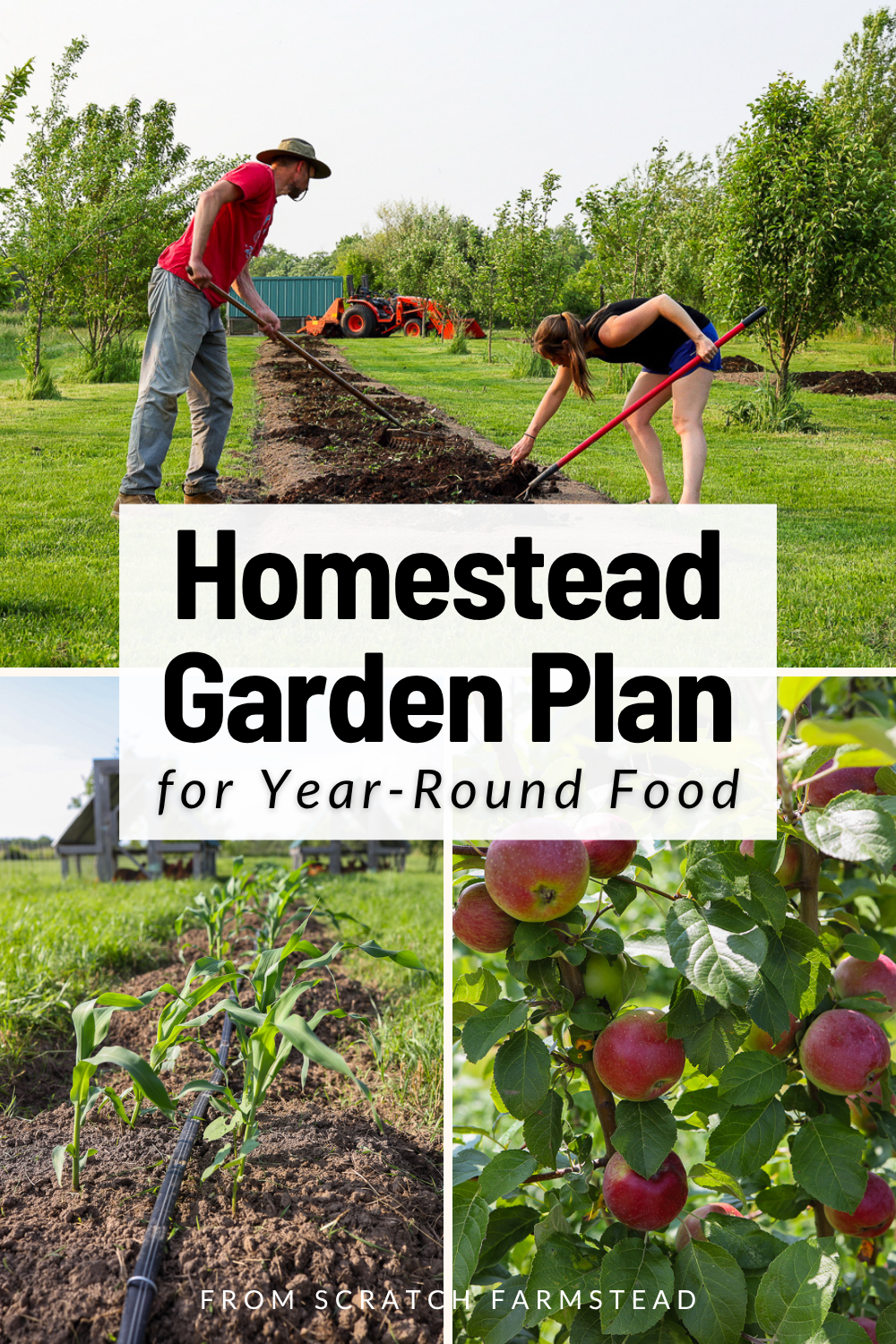
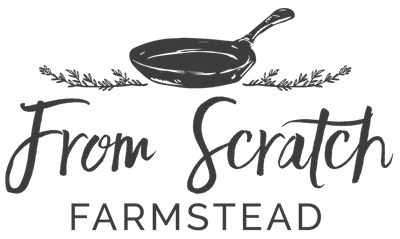
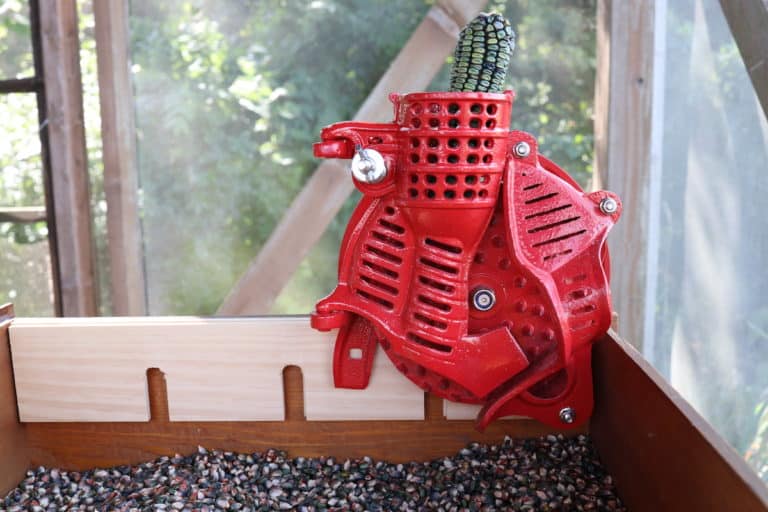
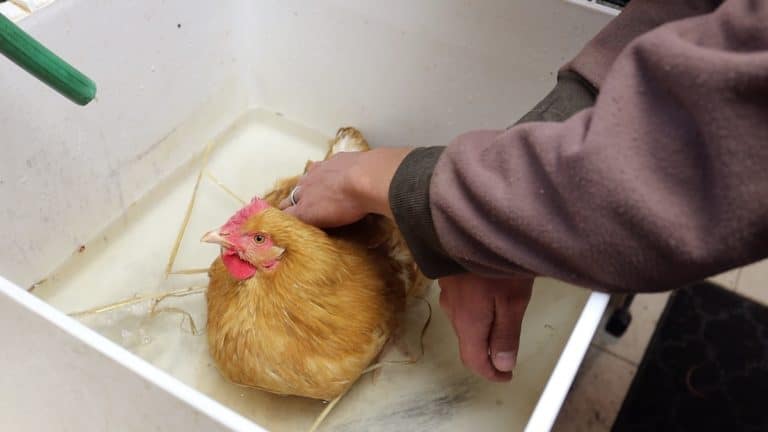

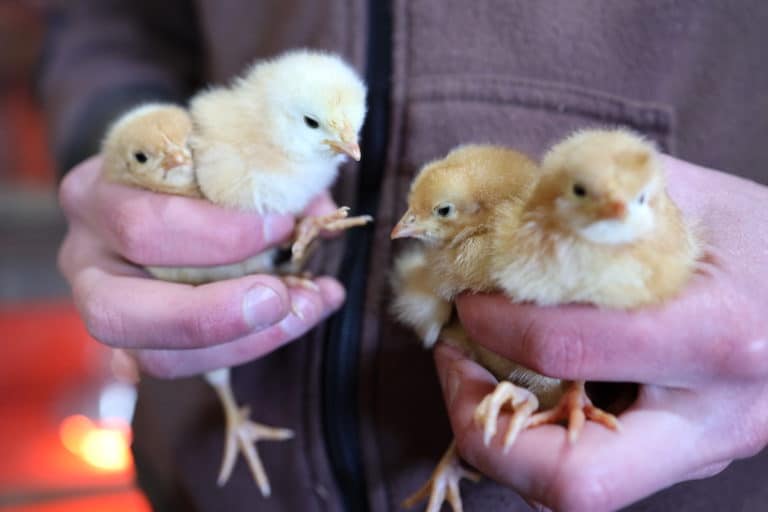
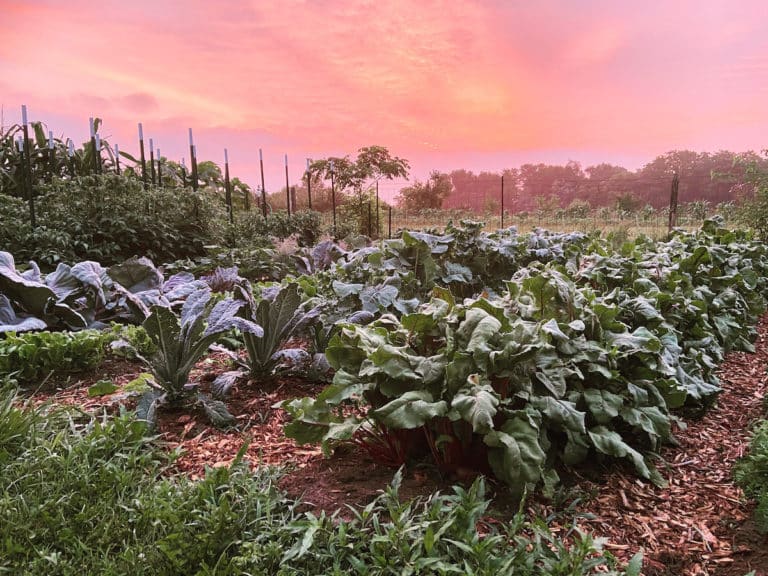
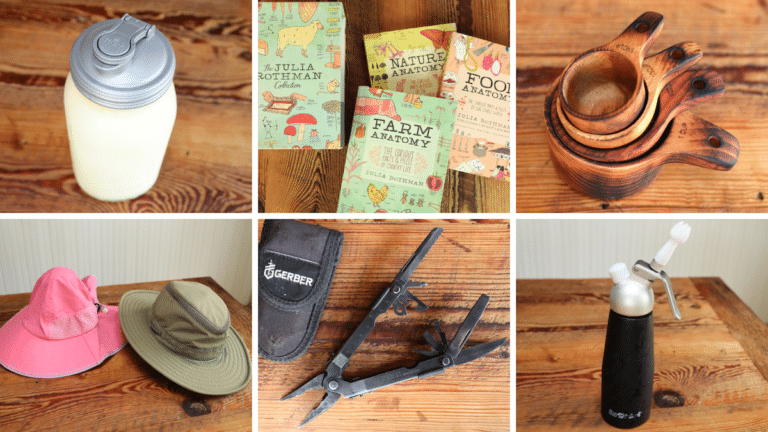
Thanks so much for your posts! Such good timing!! We are thinking of doing exactly this down yonder in New Zealand, and I am being very inspired but what you are achieving! Happy homesteading 🙂
Hello from the US! That’s so awesome – would love to hear how it ends up going for you and what you come up with. Yes, happy homesteading!
Just found your blog when searching the web to learn about chickens. I love it! Thank you for your detailed, organized How-To ideas. I can’t wait to read more.
Thanks so much for the feedback! All the best in your journey!
Read your book while I was taking Horticulture in prison, almost four years ago now. Plan was my gf and I start a farm. We broke up so I changed directions. Now ready to try this for myself. Want to see how far I can take a small town lot. For profit or just self sufficiency. Think a combination of Three sister some of your ideas. Fruit and Nut tree Nursery.
Awesome! Love hearing of people dreaming big with what they can do productively on small spaces. Wish you all the best with it and shoot over an update at some point!
This article was super helpful! Thanks for all of the great ideas!
Thanks for stopping by and so glad it was helpful!